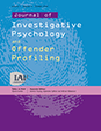A Comparison of US Police Interviewers' Notes with their Subsequent Reports
ABSTRACT
Investigators often take notes during witness interviews, which may be used when reconstructing interviews and writing reports. Little research has evaluated the content of interviewers' notes and how (accurately) they are transferred to reports. Thirteen US police investigators' notes from a witness interview were evaluated and compared with their subsequent reports. Results indicate that although information contained in notes is accurate (98%), a high percentage of interview information (68%) is omitted. Notes focus mainly on witness responses while neglecting interviewer questions/utterances. Although 94% of information contained in notes is accurately transferred to reports, interviewers fail to account for 40% of crime-relevant information in their reports. On average, reports contained a larger percentage of witness information than the notes, but police officers failed to account for how information was originally elicited via their questions/utterances. Subsequent interview reports also contained a higher percentage of peripheral crime details than notes, contributing to a decreased omission rate (28%) from notes to reports. Taken together, results indicate that interviewer notes and reports provide a fairly accurate picture of witness responses. However, they present a skewed picture of the entire interview content by omitting a high percentage of interview content and their own questions/utterances. Copyright © 2011 John Wiley & Sons, Ltd.




